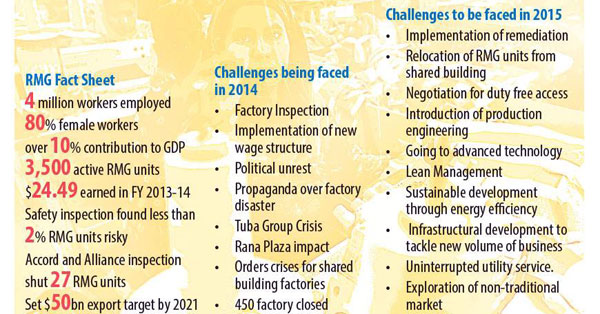Professor Mustafizur Rahman on RMG, published in Dhaka Tribune on 28 December 2014.
2014: A year of RMG transformation
Ibrahim Hossain Ovi
‘The year 2014 was viewed as a transformational year. It was also a challenging year for the RMG sector to revive from trouble it faced, and I think we have been able to turn around’
RMG owners have termed 2014 a transforming and learning year for apparel industry as the year has witnessed a lot of remedial works to turn the industrial sector compliant to ensure workers’ rights and safety.
Following the Rana Plaza building collapse, which killed 1,135 workers, and Tazreen Fashions fire incident, people across the globe raised question about the RMG workers’ rights and safety, plus electrical and structural integrity.
Following the two deadliest incidents, global buyers focused on safety issues and formed Accord on Fire and Building Safety in Bangladesh and Alliance for Bangladesh Worker Safety to promote safety standards in the country’s RMG sector.
Accord and Alliance used to source products from those factories they completed inspection. The buyers’ platforms found less than 2% factory risky to labourers’ safety.
Garment factory owners claimed that they had done a lot of remedial works as per the recommendations of Accord and Alliance. The recommendations helped them transform the factories and acquire knowledge about the safety issues and requirements.
“The year 2014 was viewed as a transformational year. It was also a challenging year for the RMG sector to revive from trouble it faced, and I think we have been able to turn around,” BGMEA Vice-President Shahidullah Azim told the Dhaka Tribune.
There were a lot of challenges including propaganda over safety issues following the Rana Plaza disaster, said Azim.
“We have done a lot of remedial works. We have overcome a crucial time. In the past, RMG owners did not have proper knowledge about the remedies, which had been acquired through recommendations that came after inspection of the factories by the buyers’ platforms,” Vidiya Amrit Khan, a BGMEA director, told the Dhaka Tribune.
RMG people have to concentrate on advanced technology to boost productivity, renewable energy and green technology for sustainable development and infrastructure development to implement the upcoming big volume production, added Amrit, also a director of Desh Garments Limited.
“We are very hopeful about a vibrant RMG future since apprehensions as regards RMG have disappeared. RMG owners and the government have to do everything in right earnest to meet the export target of $50 billion by 2021,” She added.
Bangladesh Knitwear Manufacturers and Exporters Association (BKMEA) former first vice-president Mohammad Hatem: “Challenges for the next year are to complete the remedial works and more concentration on new market exploration especially in China, South Korea, Japan and Russia.”
Special attention would be paid to negotiate with those potential countries to ensure duty-free access of Bangladesh’s RMG products to their markets, said Hatem.
Since the world concentrates more on compliance issues, Bangladesh has to carry out the remedies as per the instructions of Accord and Alliance, said Mustafizur Rahman, executive director, CPD.
If the remaining tasks are carried out as soon as possible, it would be an opportunity for Bangladesh and buyers would place orders, added Mustafizur.
Commenting on the RMG transformation that the factory owners claim to have done, the CPD official said: “It will take time to turn around but the process has started.”
To achieve the $50bn export target he urged the government and RMG factory owners to focus on non-traditional market exploration.
Though the BGMEA claimed that it had made a lot of progress, the buyers’ platforms said a lot more still needs to be done.
The RMG sector witnessed transformation this year and had made a lot of progress in terms of workers’ safety but there are some challenges ahead, M Rabin, managing director of Alliance for Workers’ Safety in Bangladesh, told the Dhaka Tribune.
The challenges include implementation of remedial works within the stipulated time frame, relocation of factories, fund management for relocation of small and medium factories and the buy of genuine fire safety equipment as they are totally dependent on import, said Rabin.
Stressing the need for quick implementation of remedial works and relocation, he said: “If the implementation is delayed, it will hamper production.”
The Alliance managing director added that gas, electricity and other utility services are mostly needed to facilitate production.
Bangladesh earned $24.49bn from RMG export in the last fiscal, which is over 81% of the total export earnings and it contributes over 10% to GDP.
The ready-made garment sector has 4 million workers, of which 80 are women, mostly from rural areas.



